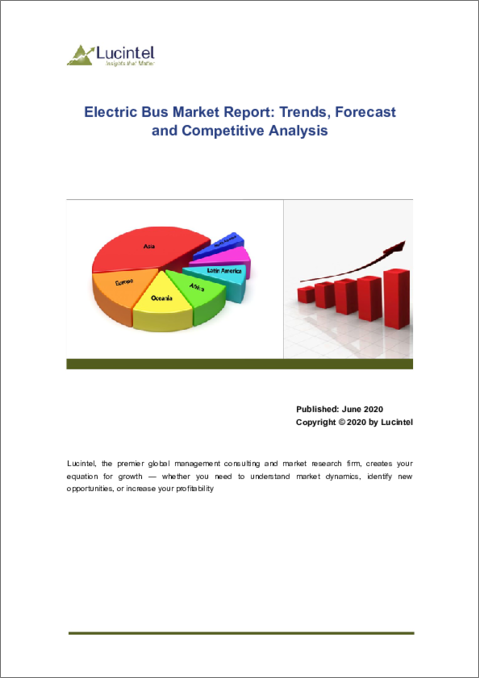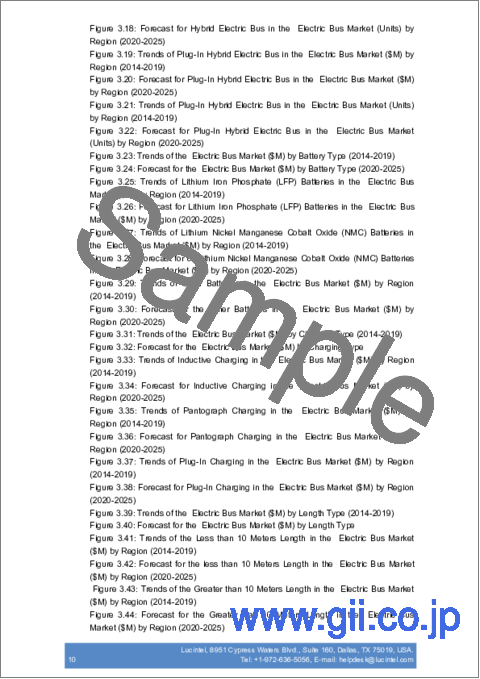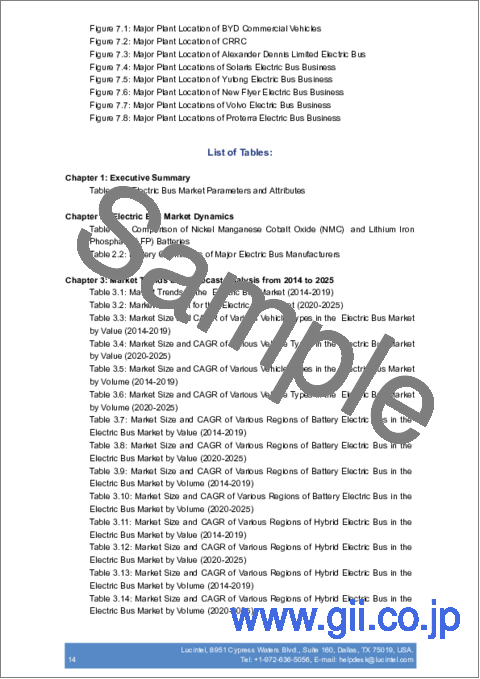|
|
市場調査レポート
商品コード
1079299
電気バス市場:動向、機会、競合分析Electric Bus Market: Trends, Opportunities and Competitive Analysis |
||||||
|
● お客様のご希望に応じて、既存データの加工や未掲載情報(例:国別セグメント)の追加などの対応が可能です。 詳細はお問い合わせください。 |
|||||||
| 電気バス市場:動向、機会、競合分析 |
|
出版日: 2022年05月01日
発行: Lucintel
ページ情報: 英文 217 Pages
納期: 3営業日
|
- 全表示
- 概要
- 目次
電気バスの市場規模は、2021年から2027年に17.2%のCAGRで成長すると予測されています。市場を牽引する主な要因にはガソリン価格の上昇、電気バスを促進するための税制優遇としての政府補助金、大気汚染を軽減するための厳しい環境規制などがあります。将来は公共交通機関や民間交通機関において機会があるでしょう。
当レポートでは電気バスの世界市場を調査し、市場規模や予測、市場の促進要因および課題、市場動向、セグメント別の市場分析、競合情勢、成長機会分析などの体系的な情報を提供しています。
目次
第1章 エグゼクティブサマリー
第2章 電気バス:市場力学
- イントロダクション、背景、および分類
- サプライチェーン
- 業界の促進要因と課題
第3章 市場動向と予測分析(2016年~2027年)
- マクロ経済動向と予測
- 市場動向と予測
- 車両タイプ別
- バッテリー式電気バス
- プラグインハイブリッド電気バス
- ハイブリッド電気バス
- バッテリータイプ別
- リン酸鉄リチウム(LFP)
- ニッケルマンガンコバルト酸化物(NMC)
- その他
- 充電インフラ別
- プラグイン
- コンダクティブ
- インダクティブ
- 長さタイプ別
- 小型バス(10メートル未満)
- 大型バス(10メートル超)
- 最終用途タイプ別
- 公共
- 民間
第4章 地域別の市場動向と予測分析(2016年~2027年)
- 地域別
- 北米
- 車両タイプ別
- バッテリータイプ別
- 充電タイプ別
- 長さタイプ別
- 最終用途タイプ別
- 欧州
- 車両タイプ別
- バッテリータイプ別
- 充電タイプ別
- 長さタイプ別
- 最終用途タイプ別
- アジア太平洋地域
- 車両タイプ別
- バッテリータイプ別
- 充電タイプ別
- 長さタイプ別
- 最終用途タイプ別
- その他の地域
- 車両タイプ別
- バッテリータイプ別
- 充電タイプ別
- 長さタイプ別
- 最終用途タイプ別
第5章 競合分析
- 製品ポートフォリオ分析
- 市場シェア分析
- 運用統合
- 地理的範囲
- ポーターのファイブフォース分析
第6章 成長機会と戦略分析
- 成長機会分析
- 車両タイプ別
- バッテリータイプ別
- 充電インフラ別
- 長さタイプ別
- 最終用途タイプ別
- 地域別
- 市場における新たな動向
- 戦略分析
- 新製品の開発
- 生産能力の拡大
- 合併、買収、合弁事業
第7章 主要企業のプロファイル
- BYD
- CRRC
- Alexander Dennis Limited
- Solaris Bus & Coach
- Zhengzhou Yutong
- New Flyer
- Volvo
- Proterra
Electric Bus Market Trends and Forecast
The future of the global electric bus market looks promising with opportunities in the public and private transportation. The global electric bus market is expected to grow at a CAGR of 17.2% from 2021 to 2027. The major drivers for this market are increasing gasoline prices, government subsidies as tax benefits to promote electric buses, and stringent environmental regulations to reduce air pollution.
Emerging Trends in the Electric Bus Market
Emerging trends, which have a direct impact on the dynamics of the industry, include development of low cost lithium ion batteries and integrated software solutions for better optimization of bus performance.
A total of 152 figures / charts and 115 tables are provided in this 217-page report to help in your business decisions. Sample figures with some insights are shown below. To learn the scope, benefits, companies researched, and other details of the global electric bus market report, please download the report brochure.
Electric Bus Market by Segments
Lucintel forecasts that battery electric bus will remain the largest segment and it is also expected to witness the highest growth over the forecast period. The study includes trends and forecast for the global electric bus market by vehicle type, battery type, charging infrastructure type, length type, end user, and region, as follows:
Electric Bus Market by Vehicle Type [Value ($ Million) and Volume (units) shipment analysis for 2016 - 2027]:
- Battery Electric Bus
- Plug-In Hybrid Electric Bus
- Hybrid Electric Bus
Electric Bus Market by Battery Type [Value ($ Million) and Volume (units) shipment analysis for 2016 - 2027]:
- Lithium Iron phosphate (LFP)
- Nickel Manganese Cobalt Oxide (NMC)
- Others
Electric Bus Market by Charging Infrastructure Type [Value ($ Million) and Volume (units) shipment analysis for 2016 - 2027]:
- Plug-In
- Conductive
- Inductive
Electric Bus Market by Length [Value ($ Million) and Volume (units) shipment analysis for 2016 - 2027]:
- Small Bus (<10 Meter)
- Large Bus ( >10 Meter)
Electric Bus Market by End Use [Value ($ Million) and Volume (units) shipment analysis for 2016 - 2027]:
- Public
- Private
Electric Bus Market by Region [Value ($ Million) and Volume (units) shipment analysis for 2016 - 2027]:
- North America
United States
Canada
Mexico
- Europe
Germany
France
Russia
United Kingdom
Italy
- Asia Pacific
China
Japan
- The Rest of the World
Brazil
Turkey
List of Electric Bus Companies
Companies in the market compete on the basis of product quality offered. Major players in this market focus on expanding their manufacturing facilities, R&D investments, infrastructural development, and leverage integration opportunities across the value chain. With these strategies electric bus companies cater increasing demand, ensure competitive effectiveness, develop innovative products & technologies, reduce production costs, and expand their customer base. Some of the electric bus companies profiled in this report includes.
- Zhengzhou Yutong Bus
- Zhuhai Yinlong
- Zhongtong
- CRRC
- Nanjing Jinlong
- Volvo
- Solaris
- VDL Bus & Coach
- Proterra
- New Flyer
Electric Bus Market Insights
- Lucintel forecasts that battery electric bus will remain the largest segment and it is also expected to witness the highest growth over the forecast period due to declining battery prices and government initiatives, such as tax benefits and subsidies to promote electric transportation.
- APAC will remain the largest region due to growing concerns on environmental pollution, government subsidies and tax rebates, and heavy investment from automaker in electric bus development. Europe is expected to witness highest growth over the forecast period due to stringent European government regulations which ensures to reduce CO2 emissions by adding more electric buses to its existing fleet.
Features of the Global Electric Bus Market
- Market Size Estimates: Global electric bus market size estimation in terms of value ($M) and volume (units) shipment.
- Trend and Forecast Analysis: Market trends (2016-2021) and forecast (2022-2027) by various segments.
- Segmentation Analysis: Global electric bus market size by various segments, such as by vehicle type, battery type, charging infrastructure type, length type, end user in terms of value and volume.
- Regional Analysis: Global electric bus market breakdown by North America, Europe, Asia Pacific, and Rest of the World.
- Growth Opportunities: Analysis of growth opportunities in different segments by vehicle type, battery type, charging infrastructure type, length type, end user, and regions for the global electric bus market.
- Strategic Analysis: This includes M&A, new product development, and competitive landscape of the global electric bus market.
- Analysis of competitive intensity of the industry based on Porter's Five Forces model
FAQ
Q1. What is the electric bus market size?
Answer: The global electric bus market is expected to reach an estimated $106.5 billion by 2027.
Q2. What is the growth forecast for electric bus market?
Answer: The electric bus market is expected to grow at a CAGR of 17.2% from 2021 to 2027.
Q3. What are the major drivers influencing the growth of the electric bus market?
Answer: The major drivers for this market are increasing gasoline prices, government subsidies as tax benefits to promote electric buses, and stringent environmental regulations to reduce air pollution.
Q4. What are the major applications or end use industries for electric bus?
Answer: Lithium iron phosphate (LFP) is the major segment by battery type for Electric bus.
Q5. What are the emerging trends in electric bus market?
Answer: Emerging trends, which have a direct impact on the dynamics of the industry, development of low cost lithium ion batteries and integrated software solutions for better optimization of bus performance.
Q6. Who are the key electric bus companies?
Answer: Some of the key electric bus companies are as follows:
- Zhengzhou Yutong Bus
- Zhuhai Yinlong
- Zhongtong
- CRRC
- Nanjing Jinlong
- Volvo
- Solaris
- VDL Bus & Coach
- Proterra
- New Flyer
Q7.Which electric bus vehicle segment will be the largest in future?
Answer: Lucintel forecasts that battery electric bus will remain the largest segment and it is also expected to witness the highest growth over the forecast period due to declining battery prices and government initiatives, such as tax benefits and subsidies to promote electric transportation.
.
Q8: In electric bus market, which region is expected to be the largest in next 5 years?
Answer: APAC will remain the largest region due to growing concerns on environmental pollution, government subsidies and tax rebates, and heavy investment from automaker in electric bus development. Europe is expected to witness highest growth over the forecast period due to stringent European government regulations which ensures to reduce CO2 emissions by adding more electric buses to its existing fleet.
Q9. Do we receive customization in this report?
Answer: Yes, Lucintel provides 10% Customization Without any Additional Cost.
This report answers following 11 key questions
- Q.1 What are some of the most promising growth opportunities for the global electric bus market by vehicle type (Plug-in hybrid electric bus, Hybrid electric bus, Battery electric bus), by battery type (Lithium Iron Phosphate, Nickel Manganese Cobalt Oxide (NMC), Others), by charging type (inductive, conductive, and plugin) by length type (<10 Meter and >10Meter), by end-use type (public and private), and by region (North America, Europe, Asia Pacific, and the Rest of the World)?
- Q.2 Which segments will grow at a faster pace and why?
- Q.3 Which region will grow at a faster pace and why?
- Q.4 What are the key factors affecting market dynamics? What are the drivers and challenges, and business risks in this market?
- Q.5 What are the business risks and competitive threats in this market?
- Q.6 What are the emerging trends in this market and the reasons behind them?
- Q.7 What are some of the changing demands of customers in the market?
- Q.8 What are the new developments in the market and which companies are leading these developments?
- Q.9 Who are the major players in this market? What strategic initiatives are being taken by key players for business growth?
- Q.10 What are some of the competing products in this market and how big of a threat do they pose for loss of market share by product substitution?
- Q.11 What M&A activity has occurred in the last five years?
Table of Contents
1. Executive Summary
2. Electric Bus Market Dynamics
- 2.1: Introduction, Background, and Classifications
- 2.2: Supply Chain
- 2.3: Industry Drivers and Challenges
3. Market Trends and Forecast Analysis from 2016 to 2027
- 3.1: Macroeconomic Trends and Forecasts
- 3.2: Electric Bus Market Trends and Forecast
- 3.3: Electric Bus Market by Vehicle Type
- 3.3.1: Battery Electric Bus
- 3.3.2: Plug-In Hybrid Electric Bus
- 3.3.3: Hybrid Electric Bus
- 3.4: Electric Bus Market by Battery Type
- 3.4.1: Lithium Iron phosphate (LFP)
- 3.4.2: Nickel Manganese Cobalt Oxide (NMC)
- 3.4.3: Others
- 3.5: Electric Bus Market by Charging Infrastructure
- 3.5.1: Plug-In
- 3.5.2: Conductive
- 3.5.3: Inductive
- 3.6: Electric Bus Market by Length Type
- 3.6.1: Small Bus (<10 Meter)
- 3.6.2: Large Bus (>10 Meter)
- 3.7: Electric Bus Market by End Use Type
- 3.7.1: Public
- 3.7.2: Private
4. Market Trends and Forecast Analysis by Region from 2016 to 2027
- 4.1: Electric Bus Market by Region
- 4.2: North American Electric Bus Market
- 4.2.1: North American Electric Bus Market by Vehicle Type
- 4.2.2: North American Electric Bus Market by Battery Type
- 4.2.3: North American Electric Bus Market by Charging Type
- 4.2.4: North American Electric Bus Market by Length Type
- 4.2.5: North American Electric Bus Market by End Use Type
- 4.3: European Electric Bus Market
- 4.3.1: European Electric Bus Market by Vehicle Type
- 4.3.2: European Electric Bus Market by Battery Type
- 4.3.3: European Electric Bus Market by Charging Type
- 4.3.4: European Electric Bus Market by Length Type
- 4.3.5: European Electric Bus Market by End Use Type
- 4.4: APAC Electric Bus Market
- 4.4.1: APAC Electric Bus Market by Vehicle Type
- 4.4.2: APAC Electric Bus Market by Battery Type
- 4.4.3: APAC Electric Bus Market by Charging Type
- 4.4.4: APAC Electric Bus Market by Length Type
- 4.4.5: APAC Electric Bus Market by End Use Type
- 4.5: ROW Electric Bus Market
- 4.5.1: ROW Electric Bus Market by Vehicle Type
- 4.5.2: ROW Electric Bus Market by Battery Type
- 4.5.3: ROW Electric Bus Market by Charging Type
- 4.5.4: ROW Electric Bus Market by Length Type
- 4.5.5: ROW Electric Bus Market by End Use Type
5. Competitor Analysis
- 5.1: Product Portfolio Analysis
- 5.2: Market Share Analysis
- 5.3: Operational Integration
- 5.4: Geographical Reach
- 5.5: Porter's Five Forces Analysis
6. Growth Opportunities and Strategic Analysis
- 6.1: Growth Opportunity Analysis
- 6.1.1: Growth Opportunities for the Electric Bus Market by Vehicle Type
- 6.1.2: Growth Opportunities for the Electric Bus Market by Battery Type
- 6.1.3: Growth Opportunities for the Electric Bus Market by Charging Infrastructure
- 6.1.4: Growth Opportunities for the Electric Bus Market by Length Type
- 6.1.5: Growth Opportunities for the Electric Bus Market by End Use Type
- 6.1.6: Growth Opportunities for the Electric Bus Market by Region
- 6.2: Emerging Trends in the Electric Bus Market
- 6.3: Strategic Analysis
- 6.3.1: New Product Development
- 6.3.2: Capacity Expansion in the Electric Bus Market
- 6.3.3: Mergers, Acquisitions, and Joint Ventures in the Electric Bus
7. Company Profiles of Leading Player
- 7.1: BYD
- 7.2: CRRC
- 7.3: Alexander Dennis Limited
- 7.4: Solaris Bus & Coach
- 7.5: Zhengzhou Yutong
- 7.6: New Flyer
- 7.7: Volvo
- 7.8: Proterra




